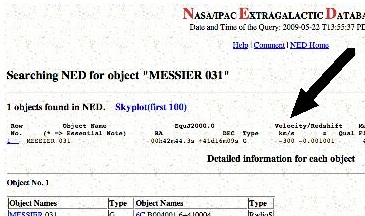
Step 1.
Find the distance from Earth to your galaxy using the measurements you made on your image.
1. Find the width of your image in cm.
2. Find the scale factor for your image - Divide 0.9 degrees by the width of your image to get a scale factor in degrees/cm
3. Measure your galaxy in cm.
4. Multiply your galaxy's measurement by your scale factor to find the angular size of your galaxy (in degrees)
5. Use the equation below to find the distance - assume your galaxy is the same size as the Milky Way: 100,000 Light Years across
Distance to object = (size of object) x (1 degree / angular size of object in degrees) x 57
Step 2.
Find the velocity with which your galaxy is moving away from earth or towards earth. Go to the NASA/IPAC ExtraGalatic Database .
At this page, enter the name of your galaxy, such as M31 or NGC 5543, where it askes for Object Name, under Input Parameters. Then click the Submit Query button at the bottom of the page.

A page will come up with a lot of information about your galaxy. In the first line, there is information about your galaxy such as its name and address in the sky. Look for the Velocity in km/sec. It will be positive if it is moving away from Earth and negative if it is moving toward Earth.
